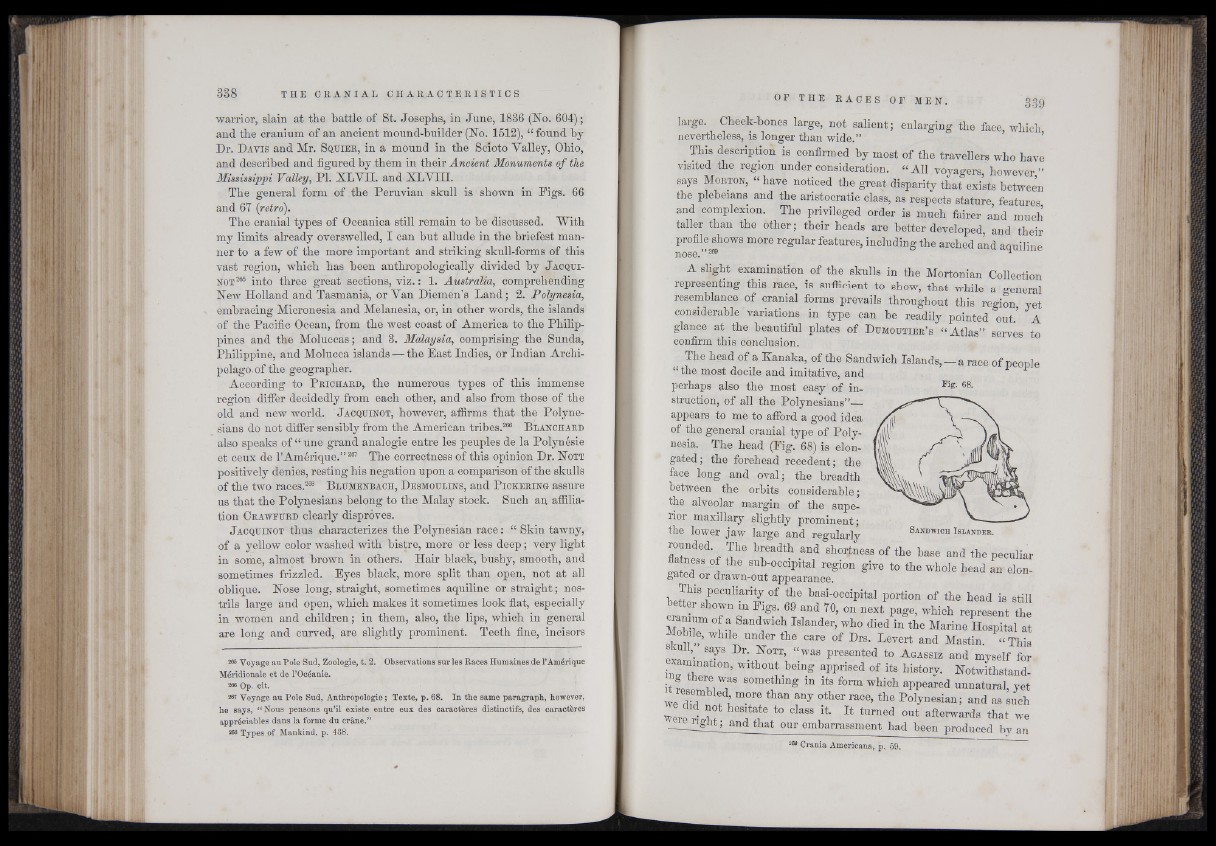
warrior, slain at the battle of St. Josephs, in June, 1836 (Ho. 604) ;
and the cranium of an ancient mound-builder (Ho. 1512), “ found by
Dr. D a v is and Mr. S q u ib b , in a mound in the Scioto Valley, Ohio,
and described and figured by them in their Ancient Monuments of the
Mississippi Valley, PI. XLVLL. and XLVIII.
The general form of the Peruvian skull is shown in Pigs. 66
and 67 (retro).
The cranial types of Oceanica still remain to be discussed. With
my limits already overswelled, I can but allude in the briefest manner
to a few of the more important and striking skull-forms of this
vast region, which has been anthropologically divided by J a c q u i-
n o t 265 into three great sections, viz. : 1. Australia, comprehending
Hew Holland and Tasmania, or Van Diemen’s Land; 2. Polynesia,
embracing Micronesia and Melanesia, or, in other words, the islands
of the Pacific Ocean, from the west coast of America to the Philippines
and the Moluccas ; and 3. Malaysia, comprising the Sunda,
Philippine, and Molucca islands — the East Indies, or Indian Archipelago,
of the geographer.
According to P r ic h a r d , the numerous types of this immense
region differ decidedly from each other, and also from those of the
old and new world. J acquinot, however, affirms that the Polynesians
do not differ sensibly from the American tribes.266 B lanchard
also speaks of “ une grand analogie entre les peuples de la Polynésie
et ceux de l’Amérique.” 267 The correctness of this opinion Dr. H ott
positively denies, resting his negation upon a comparison of the skulls
of the two races.268 B l um e n b ach , D e sm o u lin s , and P ick e r in g assure
us that the Polynesians belong to the Malay stock. Such an affilia-
tion C r aw eu r d clearly disproves.
J acquinot thus characterizes the Polynesian race : “ Skin tawny,
of a yellow color washed with bistre, more or less deep ; very light
in some, almost brown in others. Hair black, bushy, smooth, and
sometimes frizzled. Eyes black, more split than open, not at all
oblique. Hose long, straight, sometimes aquiline or straight; nostrils
large and open, which makes it sometimes look flat, especially
in women and children ; in them, also, the lips, which in general
are long and curved, are slightly prominent. Teeth fine, incisors
265 Voyage au Pole Sud, Zoologie, t. 2. Observations sur les Races Humaines de l’Amérique
Méridionale et de l’Océanie.
206 Op. cit.
267 Voyage au Pole Sud, Anthropologie ; Texte, p. 68. In the same paragraph, however,
he says, “ Nous pensons qu’il existe entre eux des caractères distinctifs, des caractères
appréciables dans la forme du crâne.”
268 Types of Mankind, p. 438.
large. Cheek-bones large, not salient; enlarging the face, which
nevertheless, is longer than wide.”
This description is confirmed by most of the travellers who have
visited the region under consideration. “ All voyagers, however ”
says Morton, “ have noticed the great disparity that exists between
the plebeians and the aristocratic class, as respects stature features
and complexion. The privileged order is much fairer and much
taller than the other; their heads are better developed, and their
profile shows more regular features, including the arched and aquiline
nose.”269
A slight examination of the skulls in the Mortonian Collection
representing this race, is suflicient to show, that while a general
resemblance of cranial forms prevails throughout this region yet
considerable variations in type can be readily pointed out. A
glance at the beautiful plates of D umo u t ier ’s “ Atlas” serves to
confirm this conclusion.
The head of a Kanaka, of the Sandwich Islands,—a race of people
“ the most docile and imitative, and
perhaps also the most easy of instruction,
of all the Polynesians”—
appears to me to afford a good idea
of the general cranial type of Polynesia.
The head (Eig. 68) is elongated;
the forehead recedent; the
face long and oval; the breadth
between the orbits considerable;
the alveolar margin of the superior
maxillary slightly prominent;
Fig. 68.
the lower jaw large and regularly S a n dw ic h I s l a n d e r .
S br dth an,d Sh01#ness 0f the base and the peculiar
S H E sub-occipital region give to the whole head an-elongated
or drawn-out appearance.
W hlS Pecul\ai% of the basi-occipital portion of the head is still
1 1 I IR E Vg--r9! Hi 7°’ °n n6Xt paSe> wbicb represent the f t S * ®an(lwich islander, who died in the Marine Hospital at
Mobile, while under the care of Drs. Levert and Mastin. “ This
dyq I I M F °TT’ “Was Presented to A gassiz and myself for
i n ^ r Wlthout beinS apprised of its history. Hotwithstandsomething
in its form which appeared unnatural, yet
esembied EBB more than any other race, the Polynesian; and as such
Were d m *° claSS | Tt turned M afterwards that we
-V ’ a that our embarrassment had been produced by an
269 Crania Americana, p, 59.